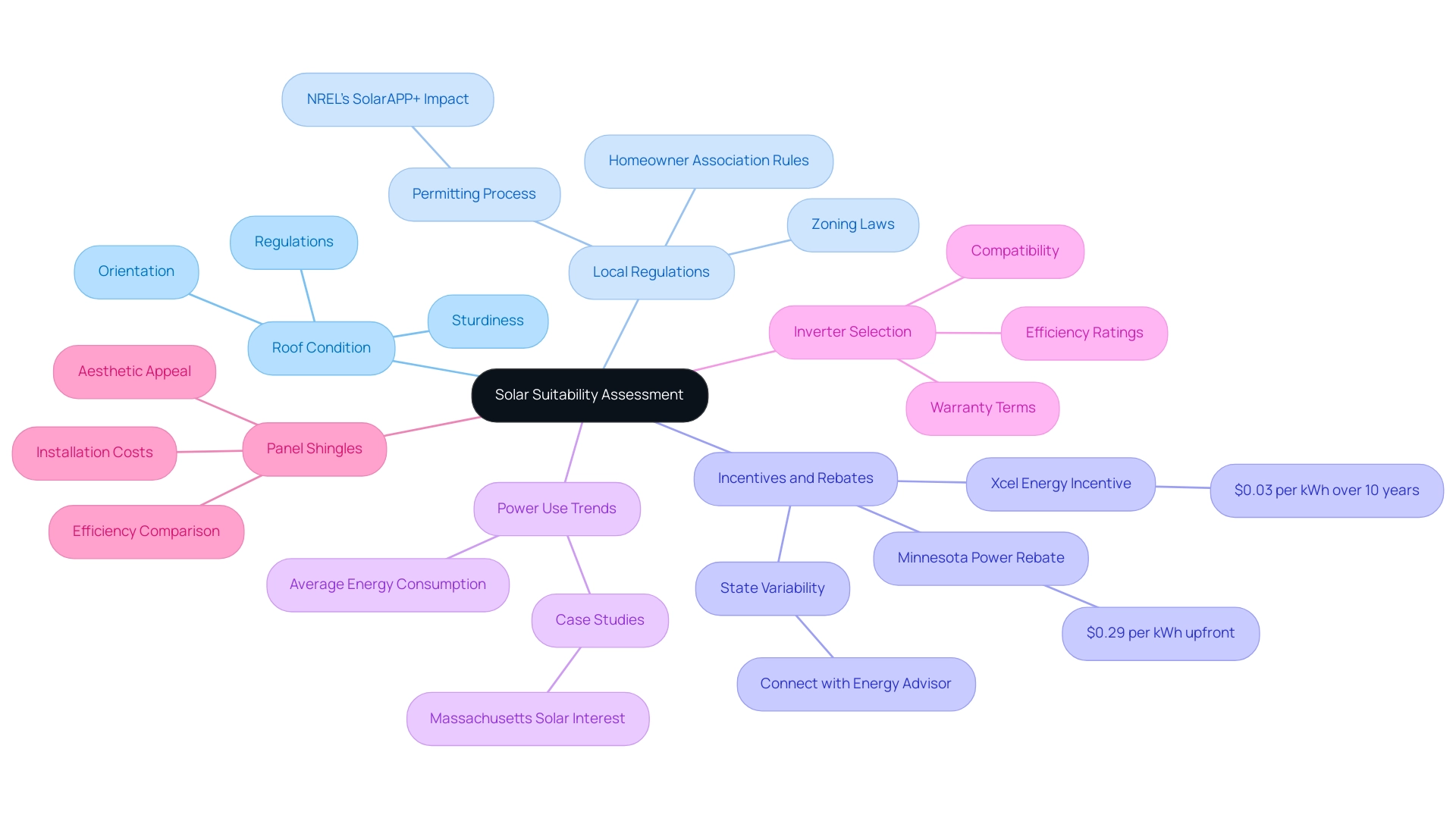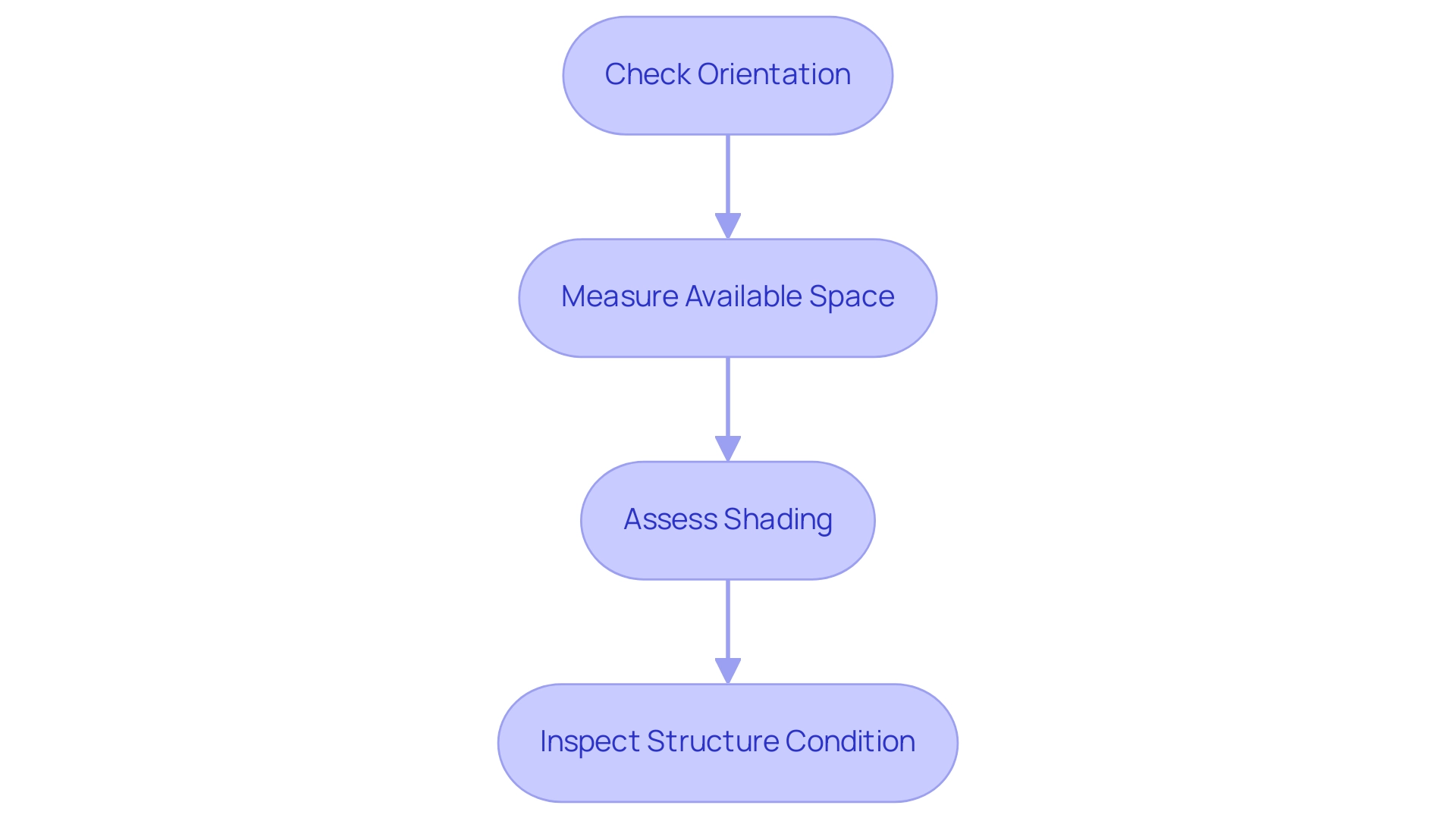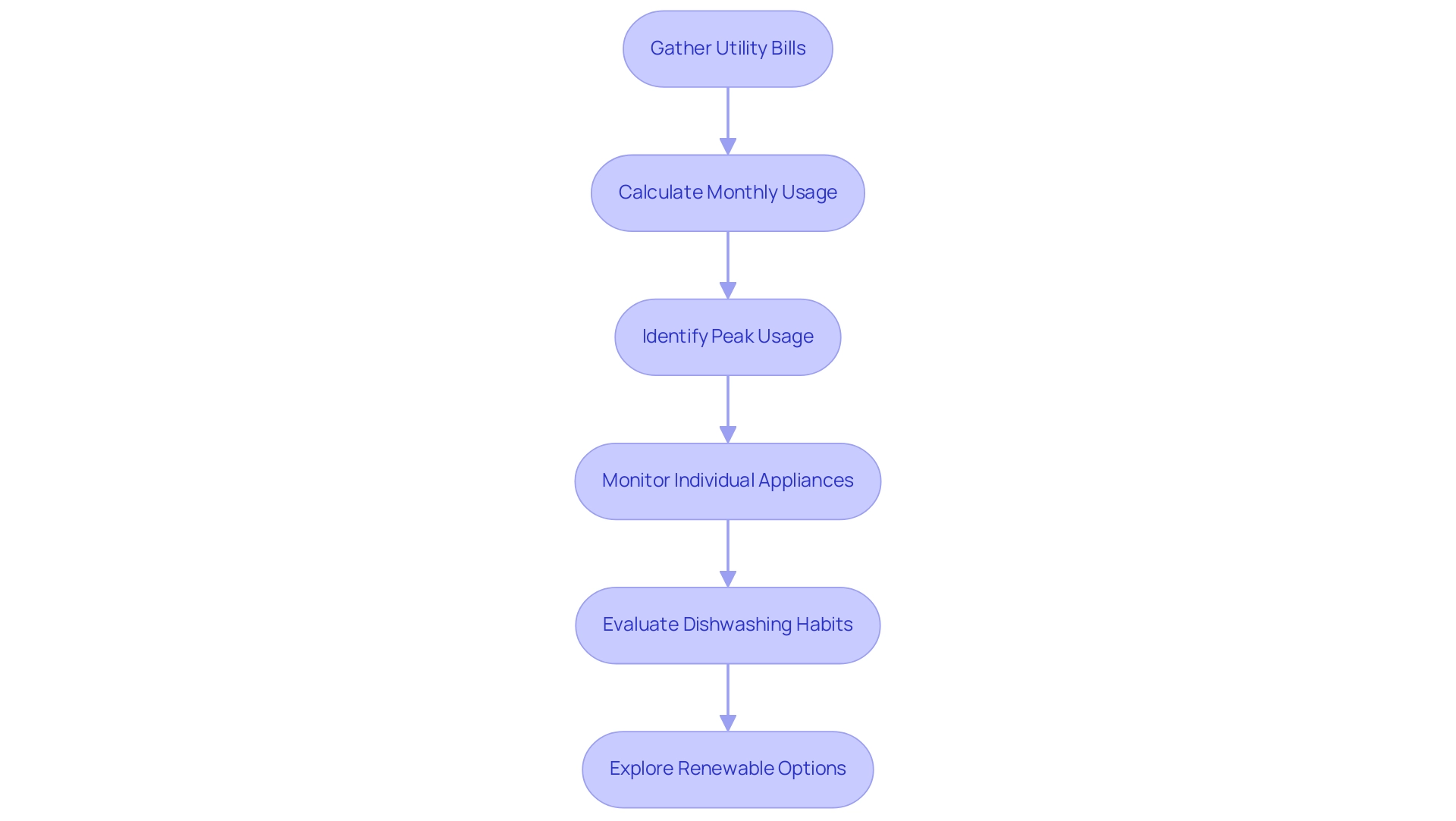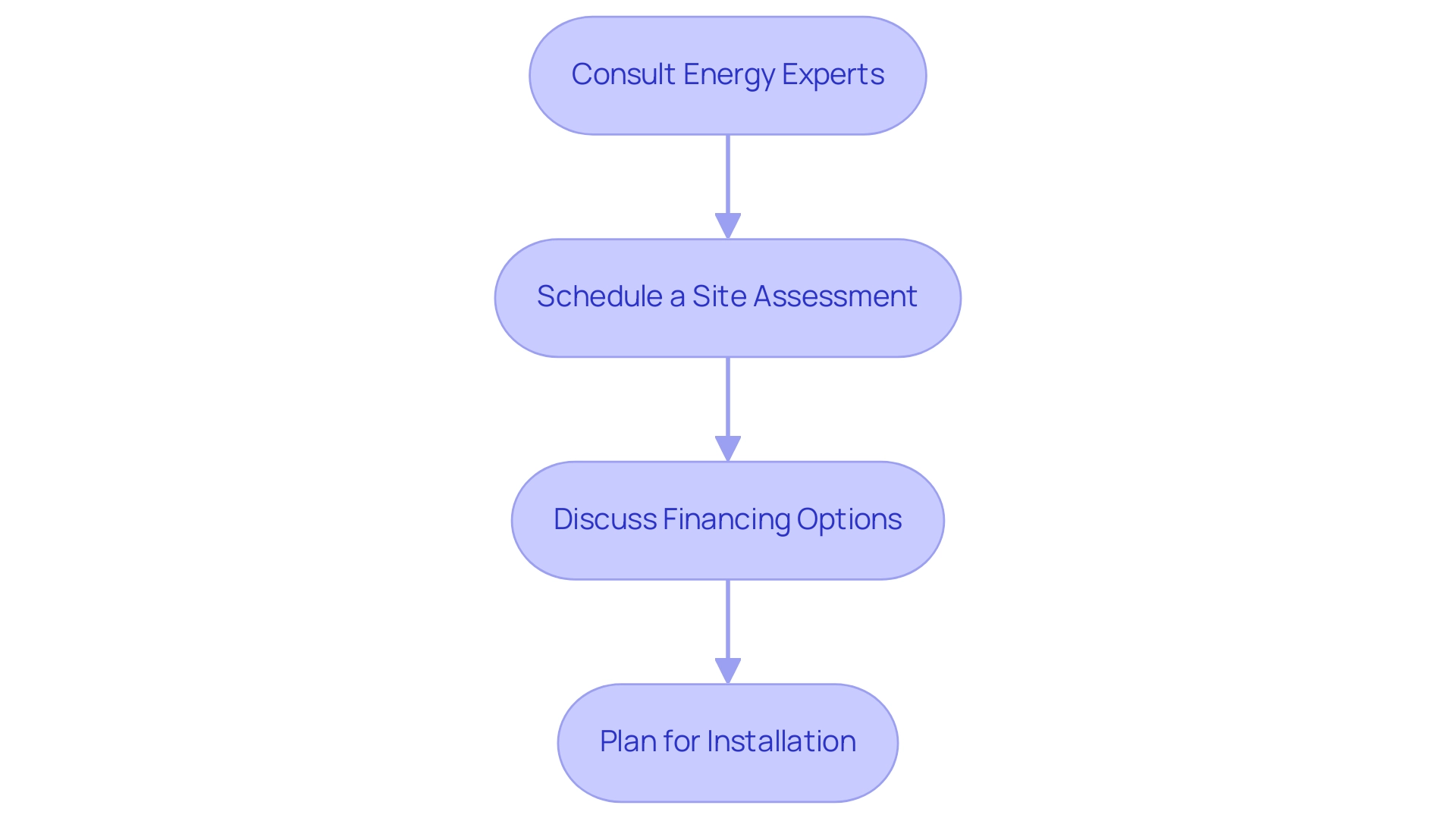Introduction
Considering a shift to solar energy can feel overwhelming for many homeowners, but it doesn’t have to be. With the right information and a bit of guidance, anyone can navigate the journey toward solar power with confidence. This article breaks down the essential factors to assess whether solar energy is a good fit for a home, from evaluating roof conditions and orientations to understanding energy consumption trends and local incentives.
By exploring these key components, homeowners can make informed decisions that not only enhance their energy independence but also contribute to a more sustainable future. Whether you’re curious about the best practices for selecting solar inverters or how climate impacts efficiency, this guide will illuminate the path to harnessing solar energy effectively.
Key Factors to Assess Solar Suitability for Your Home
When assessing if your home is a suitable candidate for renewable energy, there are several essential factors to keep in mind:
-
Roof Condition: A sturdy, well-kept covering is crucial. Not only must it support the weight of photovoltaic panels, but a structure in good condition guarantees that you won’t have to substitute it shortly after installation.
Orientation: If your structure faces south, you’re in luck! South-oriented structures generally gather the most sunlight, making them the ideal locations for energy installations. However, east and west-facing roofs can also function effectively with the appropriate arrangement, maximizing your energy output.
Local Regulations: Familiarize yourself with local zoning laws and any homeowner association rules that might affect your ability to install photovoltaic panels. Regulations can vary significantly, so knowing the landscape helps you avoid potential hurdles. Notably, 85% of installers who utilize NREL’s SolarAPP+ permitting software report that it simplifies the permitting process, streamlining your installation.
-
Incentives and Rebates: Every little bit helps when it comes to offsetting installation costs. For instance, Xcel Energy offers an annual incentive worth $0.03 per kWh of energy production over ten years, while Minnesota Power provides a generous upfront rebate of $0.29 per kWh based on expected annual production. These incentives not only lower installation expenses but also improve the overall cost-efficiency of your renewable system. It’s important to note that incentives can vary by state, and not every state is covered by the same resources. Connecting with an Energy Advisor can help you identify additional incentives available in your area, maximizing your savings!
-
Power Use Trends: Comprehending your household’s power requirements is essential. By evaluating your average energy consumption—trends evolving in 2024—you can better determine the size of the energy system that will meet your requirements.
Case Studies: For instance, in Massachusetts, local incentives and high electricity prices have spurred a growing interest in photovoltaic installations among residents. This real-world context illustrates how economic factors can influence the decision to go solar.
-
Best Practices for Selecting Inverters: When choosing inverters, consider factors such as efficiency ratings, warranty terms, and compatibility with your photovoltaic modules. Selecting high-quality inverters can significantly impact your system’s overall performance and longevity.
-
Benefits and Drawbacks of Panel Shingles: While panel shingles provide a sleek aesthetic and dual functionality as roofing material, they may come with higher installation costs and slightly reduced efficiency compared to conventional panels. Evaluating these elements can assist you in making a knowledgeable choice.
By considering these aspects, you can determine if your house is a good candidate for solar energy, ensuring a sustainable and economical energy solution.
Evaluating Your Roof: Orientation, Space, and Shading Considerations
Evaluating your roof for solar installation can be straightforward if you follow these friendly guidelines:
- Check Orientation: Start by using a compass to determine the direction your structure faces. Ideally, a south-oriented structure is optimal for sunlight capture, but don’t worry—east or west-facing structures can still produce good results.
- Measure Available Space: Confirm that you have enough unobstructed space for solar panels, aiming for at least 300 square feet. Keep in mind, a covering area of roughly 2,000 square feet can produce around 52,000 kWh of power each year, thus increased space can result in greater power generation.
- Assess Shading: Take a good look at any trees, buildings, or other structures that might cast shadows on your roof throughout the day. Shading can significantly affect solar module efficiency; studies indicate that shading can decrease energy production by as much as 20%. Therefore, using a shading analysis tool can provide you with precise measurements of sunlight exposure. Recent insights suggest that understanding shading is crucial for optimal panel performance.
- Inspect Structure Condition: Finally, check your covering for any signs of damage, such as missing shingles or leaks. If your roof isn’t in excellent condition, it might require some repairs before you can enjoy the advantages of renewable energy. As Cory O’Brien, Senior Director of Growth Marketing, wisely points out, “When determining how many panels you need, it’s important to start by thinking about what your goals are and why you want to pursue this energy source in the first place.” Taking these steps will help determine if my house is a good candidate for solar energy upgrades!
Furthermore, to gain a clearer insight into whether my house is a good candidate for solar energy, think about entering your monthly electric bill into a sunlight calculator. This tool can assist you in estimating the savings and return on investment you can achieve by utilizing renewable energy. Not only could you lower your utility expenses and enhance your independence regarding resources, but you’ll also be contributing to a more sustainable future, creating jobs, and promoting equitable access to renewable solutions.
Comprehending how photovoltaic panels function is also essential. They convert sunlight into electricity through photovoltaic cells, which generate direct current (DC) electricity. An inverter then converts this DC electricity into alternating current (AC) electricity, which powers your home.
Additionally, heating systems provide considerable financial advantages, such as lowered utility costs and enhanced property value. They also contribute to environmental sustainability by decreasing greenhouse gas emissions and reliance on fossil fuels. By investing in renewable energy technology, homeowners can enjoy long-term savings while supporting a cleaner, more sustainable future.
Understanding Your Energy Needs: Analyzing Utility Bills
To effectively assess your power requirements and plan for a photovoltaic system, especially as a Long Beach renter seeking eco-friendly solutions, follow these friendly steps:
-
Gather Utility Bills: Start by collecting your utility bills from the past year. This will provide you with a clear understanding of your power usage trends, which is essential for renewable planning.
Calculate Monthly Usage: Take a moment to note the kilowatt-hours (kWh) consumed each month. In California, for instance, the average household uses about 570 kWh monthly. By identifying your monthly consumption, you can spot consistent trends and fluctuations.
-
Identify Peak Usage: Check your bills to find the months with the highest power consumption. Identifying peak demand periods aids in comprehending when your power needs are greatest, which is essential for sizing your solar system effectively.
Consider Future Changes: Keep in mind any upcoming changes that could influence your power requirements, such as adding new appliances or undergoing home renovations. As Hannah Bastawrose wisely points out,
So, if you want to reduce your power usage, consider efficient AC systems (or adjusting your thermostat), and efficient space and water heating systems.
Additionally, be aware that air conditioning represents 19% of total power consumption in homes, while space and water heating each represent 12%. This foresight will help determine if my house is a good candidate for solar by ensuring that your solar system is appropriately sized to meet your evolving needs.
-
Monitor Individual Appliances: Consider using smart plugs to track the power usage of individual appliances. This can assist you in determining which devices are using the most power and where you can make adjustments.
-
Evaluate Dishwashing Habits: Dishwashers that operate often can contribute to your power consumption. Upgrading to energy-efficient models and running them only when full can significantly reduce consumption.
-
Explore Renewable Options: As a renter, consider alternatives like community energy programs or asking your landlord about installing energy solutions like Tesla home chargers or efficient panels. Investigating government incentives can also assist you in accessing eco-friendly power solutions. Programs like the California Solar Initiative provide rebates that can greatly lower your initial expenses.
By adhering to these steps, you’ll be well on your way to making informed choices about your renewable power system, such as determining if my house is a good candidate for solar, while maximizing both financial and ecological advantages. Solar power not only decreases your carbon footprint but can also result in significant savings on your utility bills over time.
The Impact of Climate and Sunlight on Solar Energy Efficiency
Assessing how climate and sunlight influence photovoltaic efficiency is essential for determining if my house is a good candidate for solar energy. Here are some key factors to consider:
-
Local Climate: Start by researching the climate patterns in your area.
Look at average temperatures, rainfall, and seasonal changes. For example, Nebraska recently matched 1963 for its warmest autumn on record, averaging 55 degrees F. This warm climate is advantageous for energy generation, as increased temperatures can improve efficiency and energy output. Homeowners should also explore eco-friendly panel cleaning options that can help maintain optimal performance throughout the year.
-
Sunlight Exposure: Utilize sunlight calculators or local sunlight maps to find out how many hours of sunlight your region typically receives each day.
Recent data indicates that areas with extended sunlight hours, such as those in the Southern Region, are experiencing enhanced efficiency in energy installations. In 2024, the Southern Region noted its highest temperatures, which relates to enhanced power generation from sunlight due to prolonged daylight hours and favorable weather conditions.
This is an ideal moment to explore the best methods for choosing panel inverters, ensuring that your system is compatible with your power requirements and maximizing output.
-
Seasonal Variations: Be aware of how different seasons can affect energy production from the sun.
Some areas experience significant fluctuations in sunlight, which can impact overall efficiency. For example, the record warm temperatures noted across the Southern Region in 2024 emphasize how climate changes can result in more consistent energy output throughout the year. Comprehending these variations can help you determine if my house is a good candidate for solar energy capacity and the ideal installation angle.
-
Weather Events: Extreme weather, such as heavy rains or significant snowfall—like the 65.9 inches recorded in Lewis County, New York—can impact the efficiency and upkeep of photovoltaic panels.
These extreme weather events can obstruct sunlight and require regular maintenance to ensure optimal performance. It’s essential to consider how these events can affect the longevity and efficiency of your energy setup.
As an eco-conscious homeowner, staying informed about government programs that support renewable power adoption and recent advancements in photovoltaic technology, such as Tesla home chargers and battery storage solutions, can also enhance your understanding and usage of sustainable resources.
By taking the time to analyze these factors, you’ll be better equipped to understand how climate influences efficiency and make a more informed decision for your home, especially as a renter in Long Beach looking for eco-friendly power solutions.
Next Steps: Consulting Professionals and Conducting Site Assessments
After completing your self-assessment, it’s time to take some exciting next steps to harness the power of solar energy for your home with Powercore Electric, your trusted partner in California:
- Consult Energy Experts: Don’t hesitate to reach out to Powercore Electric, your local electrical professionals. They can provide expert advice tailored to your unique situation, ensuring you get the best possible guidance. As Jason Kaminsky, CEO of kWh Analytics, emphasizes, “Our industry’s ability to collaborate and innovate remains one of our greatest strengths.”
- Schedule a Site Assessment: A professional site assessment is crucial. Powercore’s team can assess if my house is a good candidate for solar energy potential with precision and provide tailored suggestions to maximize your benefits. Their thorough assessments of sunlight systems involve examining your roof’s orientation, shading, and power usage trends. Precise evaluations are crucial, particularly given that GHI, DNI, and DHI percentages have decreased by 1.81%, 3.21%, and 4.85% over the last 24 months, which may impact power generation.
- Discuss Financing Options: Financing shouldn’t be an obstacle to adopting renewable energy. Engage in a conversation with Powercore Electric about various options like loans, leases, and power purchase agreements (PPAs). These can make renewable power considerably more economical for you and enable you to secure a low rate amidst increasing utility expenses.
- Plan for Installation: If you’re ready to move forward, work closely with Powercore’s installers to create a comprehensive timeline. It’s essential to ensure that all permits are obtained and that you’re prepared for a smooth installation process.
By adhering to these steps and recognizing the significance of precise site evaluations, as demonstrated in the case study on techniques for gathering irradiance and weather information, you’ll be well on your path to determining if my house is a good candidate for solar energy. Don’t wait to start your journey towards energy independence and financial savings—Get in Touch with Powercore Electric today for your free, personalized estimate! You’ll feel supported by the community of solar professionals at Powercore Electric, ready to assist you in achieving your goals!
Conclusion
Considering a transition to solar energy involves several critical factors that can empower homeowners to make informed decisions. By evaluating roof conditions, orientations, and local regulations, individuals can identify if their home is a suitable candidate for solar installation. Understanding energy consumption trends and available incentives further enhances the decision-making process, allowing for a tailored approach to solar adoption.
As homeowners assess their unique needs, they can leverage tools like solar calculators and engage with local solar professionals for personalized guidance. This proactive approach not only maximizes potential savings but also contributes to a sustainable future. Recognizing the impact of climate and sunlight on solar efficiency is equally important, as these elements can significantly influence the performance of solar systems.
Ultimately, embracing solar energy is a step towards energy independence and environmental responsibility. By taking the time to explore the various aspects of solar energy, homeowners can confidently embark on their solar journey, paving the way for a greener and more cost-effective energy solution. The future of energy is bright, and with the right resources and support, anyone can harness the power of the sun for their home.







